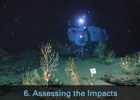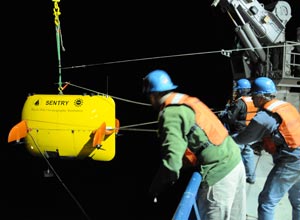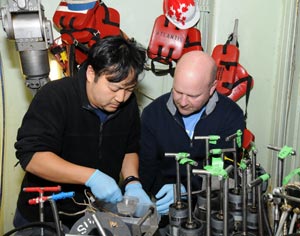Deepwater Horizon, 2010 In December 2010, the submersible Alvin and autonomous underwater vehicle (AUV) Sentry went to the Gulf of Mexico to help scientists get a close-up look the seafloor near the source of the oil spill. Use of the two vehicles in tandem to identify and explore sites of interest represents a promising model for future deep-water exploration. The pairing enabled researchers on the cruise to maximize use of their time on the bottom during the short, six-day cruise. Funded by the National Science Foundation under the agency’s Rapid Response Program, scientists took advantage of Alvin’s presence in the Gulf after an already-scheduled series of dives and Sentry’s availability between missions to put together an ambitious plan that took them to previously unexplored parts of the seafloor to look for signs of impacts to ecosystems on the seafloor. Their primary focus was a region first discovered by the remotely operated vehicle (ROV) Jason in November containing corals and other animals that displayed behavior and coloration the scientists (all of whom have extensive experience studying the same or similar organisms) had never seen before. The work was an extension of the Lophelia II project, an ongoing study funded by NOAA and the Bureau of Ocean Energy Management, Regulation and Enforcement (formerly the Minerals Management Service) to examine the composition, diversity, and distribution of communities inhabiting hard-bottom areas of the Gulf and of places where hydrocarbons naturally seep from the seafloor. During the cruise, Sentry would scout the bottom over night with its sidescan sonar and high-resolution imagery for promising locations. In the morning, researchers reviewed Sentry’s data in time to refine their dive plan for Alvin that day. From Oceanus Magazine May 5, 2011
May 5, 2011Life and Death in the Deep Sea A team of scientists that had been studying deep-sea coral communities on the Gulf of Mexico seafloor before the oil spill was in perfect position to assess impacts afterwards. Source: Oceanus Magazine Related Multimedia Science in a Time of Crisis, Chapter 6: Assessing the Impacts
Science in a Time of Crisis, Chapter 6: Assessing the ImpactsWHOI's Response to the Deepwater Horizon Oil Spill Related Expeditions Dive and Discover Expedition to the Gulf of Mexico
Dive and Discover Expedition to the Gulf of MexicoDecember 6 – 14, 2010  Lophelia II 2010: Oil Seeps and Deep Reefs
Lophelia II 2010: Oil Seeps and Deep ReefsOctober 14 – November 4, 2010 Related Technology HOV Alvin
HOV AlvinThis human-occupied vehicle (HOV) carries up to three people (one pilot and two observers) as deep as 4500 meters beneath the ocean surface and was deployed in the Gulf to look for potential impacts of the oil on deep-water ecosystems in the Gulf.  AUV Sentry
AUV SentryAn autonomous underwater vehicle (AUV) developed at WHOI and used to study the composition of the Gulf oil plume and to photograph and map the seafloor. Last updated: May 5, 2011 | ||||||||||||||||
Copyright ©2007 Woods Hole Oceanographic Institution, All Rights Reserved, Privacy Policy. | ||||||||||||||||



